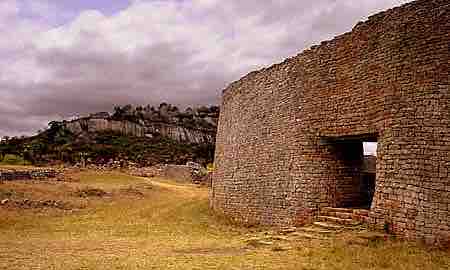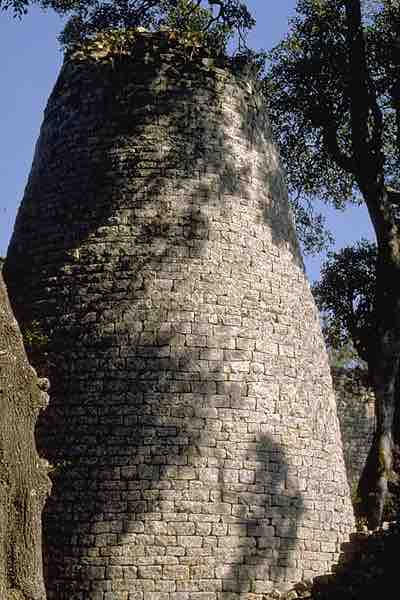Perhaps the most famous site in southern Africa, Great Zimbabwe is a ruined city constructed by the Mwenemutapa. A monumental city built of stone, it is one of the oldest and largest structures in southern Africa. Located about 150 miles from the modern Zimbabwean capital of Harare, Great Zimbabwe was the capital of a medieval kingdom that occupied the region on the eastern edge of Kalahari Desert.
As there is no written records from the people who inhabited Great Zimbabwe, knowledge of the culture is dependent on archaeology. Small farming and iron-mining communities began to appear in the area between the fourth and seventh centuries CE. Most were cattle pastoralists, but the discovery of gold and new mining techniques contributed to a rise in trade with caravan merchants to the north. As local leaders became rich from trade, they grew in power and created the centralized city-state of Great Zimbabwe.
Construction of the monument began in the eleventh century and continued through the fourteenth century, spanning an area of 1,780 acres and covering a radius of 100 to 200 miles. At its peak, it could have housed up to 18,000 people. The load-bearing walls of its structures were built using granite with no mortar, evidence of very skilled masonry. The ruins form three distinct architectural groups, known as the Hill Complex (occupied from the ninth-thirteenth centuries), the Great Enclosure (occupied from the thirteenth through fifteenth centuries), and the Valley Complex (occupied from the fourteenth through sixteenth centuries).
One of its most prominent features of Great Zimbabwe was its walls, some of which reached five to 11 meters high and extended approximately 820 feet.

Close-up of Great Zimbabwe
Great Zimbabwe is most famous for its enormous walls, built without mortar.
There are stone structures linked by passageways, and some parts of the site incorporate natural rock formations into the design, as is evident in at least one structure in the Hill Complex.
Hill Complex
Ruins of a building from the Hill Complex, where the naturally occurring rock formations were built into part of the foundation.
Notable features of the Hill Complex include the Eastern Enclosure, a high balcony enclosure overlooking the Eastern Enclosure, and a huge boulder in a shape similar to that of the Zimbabwe Bird. The Great Enclosure is composed of an inner wall, encircling a series of structures, and a younger outer wall. The most important artifacts recovered from the monument are the eight Zimbabwe Birds. These birds were carved from a soapstone on the tops of monoliths that were the height of a person. Slots in a platform in the Eastern Enclosure of the Hill Complex appear designed to hold the monoliths with the Zimbabwe birds, but archaeologists cannot be sure that this is where the birds rested.
Eastern Enclosure
View west from the Eastern Enclosure, Great Zimbabwe, showing the granite boulder (far right) that resembles the Zimbabwe Birds. A copy of one of the famous sculptures is shown below for comparison.
Zimbabwe Bird
Copy of Zimbabwe Bird soapstone sculpture.
The Conical Tower was constructed between the two walls. The Valley Complex is divided into the Upper and Lower Valley Ruins, with different periods of occupation.

The Conical Tower
The Conical Tower is 18 feet (5.5 meters) in diameter and 30 feet (9.1 meters) high.
Valley Complex ruins
Ruins of the foundations demonstrate the same level of skill seen in the more intact walls elsewhere in Great Zimbabwe.
One theory suggests that the complexes were the work of successive kings. Perhaps the focus of power moved from the Hill Complex to the Great Enclosure in the twelfth century, then to the Upper Valley, and finally to the Lower Valley in the early sixteenth century. A more structuralist interpretation holds that the different complexes had different functions. For example the Hill Complex was a temple, the Valley Complex was built for the citizens, and the Great Enclosure was used by the king.
Great Zimbabwe shows a high degree of social stratification, characteristic for centralized states. For the elite, there seems to have been a great deal of wealth. Plentiful pottery, iron tools, copper and gold jewelry, elaborately worked ivory, bronze spearheads, gold beads and pendants, and soapstone sculptures have all been found at the site. Some of the artifacts, such as ceramics and glass vessels, appear to have come from Arabia, India, and even China, suggesting that Great Zimbabwe was a major trade center. Smaller stone settlements called zimbabwes can be found nearby. These are thought to be seats of authority for local governors acting under the king of Great Zimbabwe. These smaller settlements would have been supported by surrounding farmers.
Great Zimbabwe was abandoned by 1500, possibly due to land exhaustion, drought, famine, or a decline in trade. Zimbabwean culture would continue in Mutapa, centered on the city of Sofala. The site of Great Zimbabwe is considered a source of pride in the region, and the modern nation of Zimbabwe derived its name from the site. Nonetheless, when European colonizers first found the ruins in the late nineteenth century, most did not believe that the site could have been built by indigenous Africans. In fact, political pressure was put on historians and architects to deny its construction by black people until Zimbabwe's independence in the 1960s.